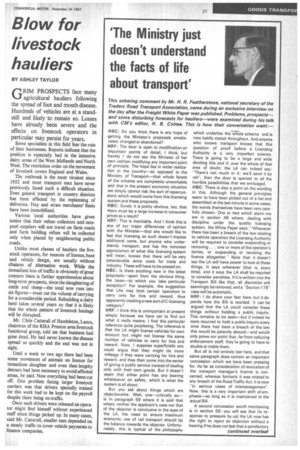Blow for livestock hauliers
Page 23

If you've noticed an error in this article please click here to report it so we can fix it.
BY ASHLEY TAYLOR
GRIM PROSPECTS face many agricultural hauliers following the spread of foot and mouth disease. Hundreds of vehicles are at a standstill and likely to remain so. Losses have already been severe and the effects on livestock operators in
particular may persist for years.
Some specialists in this field fear the ruin of their businesses. Reports indicate that the position is especially bad in the intensive dairy areas of the West Midlands and North West. The restriction order on the movement of livestock covers England and Wales.
The outbreak is the most virulent since 1932 and most transport men have never previously faced such a difficult situation. Even general transport in country districts has been affected by the replanning of deliveries. Hay and straw merchants' fleets have been immobilized.
Various local authorities have given notice that their refuse collectors and cesspool emptiers will not travel on farm roads and farm building refuse will be collected only when placed by neighbouring public roads.
Unlike most classes of hauliers the livestock operators, for reasons of licence, base and vehicle design, are usually without chances of alternative work. While the immediate loss of traffic is obviously of great concern there is further apprehension about long-term prospects, since the slaughtering of cattle and sheep—the total now runs into six figures—must cut the volume of carrying for a considerable period. Rebuilding a dairy herd takes several years so that it is likely that the whole pattern of livestock haulage will be disrupted.
Mr. Chris Catterall of Hambleton, Lanes, chairman of the RHA Preston area livestock functional group, told me that business had gone dead. He had never known the disease spread so quickly and the end was not in sight.
Until a week or two ago there had been some movement of animals on licence for immediate slaughter and even then lengthy detours had been necessary to avoid affected areas, he said. Now everything had been cut off. One problem facing larger livestock carriers was that drivers specially trained for this work had to be kept on the payroll despite there being no traffic.
Once such drivers were released an operator might find himself without experienced staff when things picked up. In many cases, said Mr. Catterall, smaller men depended on a steady traffic to cover vehicle payments to . finance companies.












































































































































